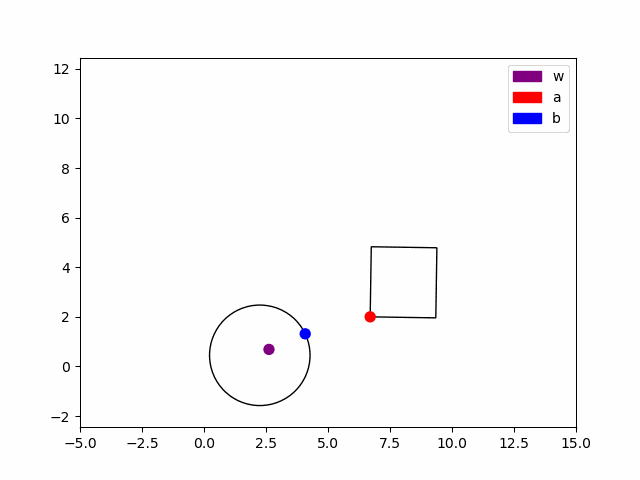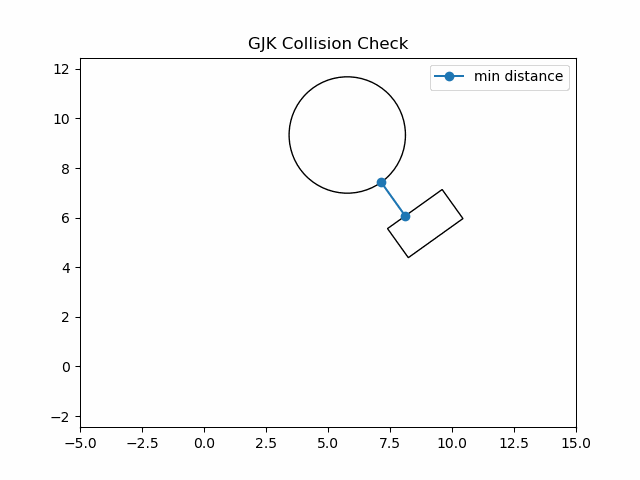你我来自湖北四川广西宁夏河南山东贵州云南的小镇乡村, 曾经发誓要做了不起的人.
*—你曾是少年 S.H.E*
🏰代码及环境配置:请参考0.2 环境配置和代码运行 | 动手学运动规划!
本节提供了GJK算法的代码测试.
python3 tests/basic/gjk_collision_check_test.py
1.4.c.1 GJK代码实现
tests/basic/gjk.py 提供了GJK算法的实现,该实现不仅仅返回碰撞结果,还计算了最小距离.
这里我们介绍一下主流程run_gjk() ,他接受两个二维凸集和一个初始方向作为输入.
- 首先基于初始方向计算了shape1, shape2两相反方向上的边界点, 然后相减得到Minoski差集合的边界点的向量v( O P p → \overrightarrow{OP_p} OPp).
- 利用向量v,计算Minoski差集合边界上的第一个单纯形点w
- 初始化单纯形S, S1和S2分别是单纯形S对应的 shape1和shape2上的原始点,因为算法需要计算最小距离
- 进入循环,停止条件 代表当前最小距离的v.dot(v) > 代表新的最小距离的v.dot(w), 也就是无法找到更小距离的点了
- 循环内find_first_unset使用了数学技巧来找b中第一个0的位置索引
- 我们可视化了每一次迭代的w,a,b点
def run_gjk(shape1, shape2, a0=np.array([1, 0]), eps=0.001):
"""Gilbert-Johnson-Keerthi distance algorithm.
Parameters:
shape1, shape2: shapes to calculate distance between
a0: arbitrary initial direction
Returns:
Distance between the shapes (0 if they intersect),
points v1, v2 representing the closest points on the first and
second shapes, respectively."""
# arbitrary point in Minoski diff
v = shape1.support(a0) - shape2.support(-a0)
# direction to origin from closest point
a = shape1.support(-v)
b = shape2.support(v)
w = a - b
# initialize simplex
S = np.zeros((2, 3))
bitset = 0
# to compute the closest points on the shapes, in addition to the distance,
# we need to keep track of the points from each shape used to compute the
# simplex
S1 = np.zeros((2, 3))
S2 = np.zeros((2, 3))
# iterate until w is no more extreme in the direction v than v itself
while v.dot(v) - v.dot(w) > eps:
# add new point to simplex
i = find_first_unset(bitset)
bitset = set_bit(bitset, i)
S[:, i] = w
S1[:, i] = a
S2[:, i] = b
# compute closest point to the origin in the simplex, as well the
# smallest simplex that supports that point
v, bitset, contains_origin, coeffs = johnson(S, bitset)
if contains_origin:
break
# recompute direction
a = shape1.support(-v)
b = shape2.support(v)
w = a - b
# compute closest points using the same coefficients as the closest point
# of the Minowski diff to the origin v
idx = bit_indices(bitset)
v1 = coeffs.dot(S1[:, idx].T)
v2 = coeffs.dot(S2[:, idx].T)
distance = np.sqrt(v.dot(v))
return distance, v1, v2

循环中调用了johnson算法来计算单纯形上与原点的最近距离的点,代码如下:
def johnson(points, this_bitset):
"""Johnson distance algorithm
Parameters:
points: 2x3 matrix of points in the simplex
this_bitset: 3-bit number representing the active members of the
simplex
Returns:
v: the closest point of this simplex to the origin
bitset: the bitset of the smallest sub-simplex supporting v
contains_origin: True if the sub-simplex contains the origin
coeffs: Coefficients for the points in the sub-simplex to v via
convex combination"""
# store deltas: row is indexed by the points in the set X; column indexed
# by delta index
# {y1} represented by 001, {y2} by 010, etc
D = np.zeros((8, 3))
# singleton sets are unity
D[0b001, 0] = 1
D[0b010, 1] = 1
D[0b100, 2] = 1
# calculate deltas
# this implementation requires bitset array to be ordered in increasing
# number of bits
for bitset in BITSETS:
if bitset & this_bitset != bitset:
continue
for i in range(3):
bitset_no_i = unset_bit(bitset, i)
if bitset_no_i != 0 and get_bit(bitset, i):
k = find_first_set(bitset_no_i)
yk = points[:, k]
yi = points[:, i]
D[bitset, i] = np.sum(
[
D[bitset_no_i, j] * (yk - yi).dot(points[:, j])
for j in bit_indices(bitset_no_i)
]
)
for bitset in BITSETS:
# only iterate bit sets that contain members of the current bitset
if bitset & this_bitset != bitset:
continue
# check conditions for this bit set to contain the closest point
contains_closest_pt = True
for j in range(3):
if get_bit(bitset, j) and D[bitset, j] <= 0:
contains_closest_pt = False
elif not get_bit(bitset, j) and D[set_bit(bitset, j), j] > 0:
contains_closest_pt = False
if contains_closest_pt:
idx = bit_indices(bitset)
coeffs = D[bitset, idx] / np.sum(D[bitset, idx])
v = coeffs.dot(points[:, idx].T)
contains_origin = bitset == 0b111
return v, bitset, contains_origin, coeffs
1.4.c.1 GJK代码测试

在tests/basic/gjk_collision_check_test.py 中,生成了随机的矩形和圆,调用gjk算法来计算最小距离和对应的点
for i in range(0, 10):
plt.cla()
# test shapes
x1 = random.uniform(0.0, 10.0)
y1 = random.uniform(0.0, 10.0)
theta1 = random.uniform(-pi, pi)
length1 = random.uniform(2.0, 4.0)
width1 = random.uniform(1.0, 3.0)
box1 = Box(x1, y1, theta1, length1, width1)
shape1 = gjk.Polygon(get_xy_matrix(box1.corners))
x2 = random.uniform(0.0, 10.0)
y2 = random.uniform(0.0, 10.0)
r2 = random.uniform(1.0, 3.0)
shape2 = gjk.Circle(c=(x2, y2), r=r2)
# calculate distance and closest points on shapes
d, v1, v2 = gjk.run_gjk(shape1, shape2)
print(d)
🏎️自动驾驶小白说官网:https://www.helloxiaobai.cn
🐮GitHub代码仓:https://github.com/Hello-Xiao-Bai/Planning-XiaoBai!
🔥淘宝官方店铺:https://shop380995420.taobao.com
🌠代码配合官网教程食用更佳!
🚀知乎,微信,知识星球全平台同号!






















 2000
2000

 被折叠的 条评论
为什么被折叠?
被折叠的 条评论
为什么被折叠?








